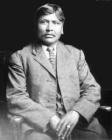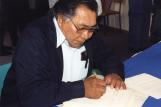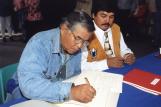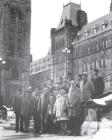1
CONTENTS:- Land Claims: The First Attempts
- Land Claims in the 1970s
- Rejecting the Agreement-in-Principle,1984
- 1993: Success, Finally!
- After the Land Claim: Implementation
2
Land Claims - The First AttemptsActually, the first attempt at a Yukon First Nation land claim was made by Jim Boss (Kashxoot) of the Ta'an Kwäch'än in 1902 (he also had strong ties to Big Salmon people). He had his lawyer write to the Superintendent of Indian Affairs, asking for protection for his people: "Tell the king very hard we want something for our Indians because they take our land and our game". The government wasn't interested in negotiating because it did not want to acknowledge special rights for First Nations peoples.
3
Chief Jim Boss (Kashxoot) of the Ta'an Kwachän people1900
 Credits:
Credits:(cropped from Yukon Archives PHO 417 91-38 #2)
4
Land Claims in the 1970sAs years passed, the situation become so bad (see the last section called "K'uch'an Adäw") that First Nations people had to act. The Trudeau government's "White Paper" of 1969 stated their plans to make First Nations peoples equal to all other Canadians, leaving them no special rights. First Nations people from across the country reacted very strongly against this plan. In 1973, the Yukon Native Brotherhood sent a delegation to Ottawa to deliver a document called "Together Today for Our Children Tomorrow" to the government; Carmacks Elder George Billy was a memeber of this group. "Together Today" called for a negotiated land claim that recognized First Nations traditional rights to their lands.
8
Rejecting the Agreement-in-Principle, 1984The Council for Yukon Indians (CYI) was formed in 1975 to negotiate a land claim for Yukon First Nations. After many years of work, they had managed to produce an Agreement-in-Principle (AIP) with the Canadian government. But when they took they AIP back to the CYI General Assembly at Tagish in 1984, it was rejected. There were several reasons for this; the AIP did not did not recognize Aboriginal title (inherent right to use the land), did not give First Nations people priority hunting and fishing rights, and did not include self-governement for each First Nation.
This was a hard choice for Yukon First Nations, but they soon went back to work. CYI lobbied the Canadian government to rethink its approach to negotiating land claims. Following a scathing report by the Coolican Task Force, Canada adopted a new Comprehensive Claims Policy in 1986 that recognizes Aboriginal title. This allowed the land claim ball to start rolling again in the Yukon.
10
1993: Sucess, Finally!After the Canadian government changed its posisiton on Aboriginal title, CYI went back to work negotiating a land claim. On May 29, 1993 the Umbrella Final Agreement (UFA) was accepted by the CYI General Assembly. This document covered all the major points of the land claim, and then each First Nation would negotiate its own Final Agreement with specific additions. The UFA included all the things the Agreement-in-Principle was missing: regognition of Aborignal title, special hunting and fishing rights, and self-government for each First Nation. It also included much more Settlement Land than the AIP had offered.
LSCFN soon negotiated its Final Agreement, and it was ratified on July 21, 1997. After decades of hardhsip and more than 20 years of negotiations, Northern Tutchone people had finally recliamed self-government!
11
Elder Councillor Billy Peter Johnnie signing the LSCFN Final Agreement1997
Carmacks, Yukon
 Credits:
Credits:(© LSCFN 1997)
12
Elder Johnny Sam signs the LSCFN Final Agreement while Chief Eddie Skookum looks on1997
Carmacks, Yukon
 Credits:
Credits:(© LSCFN 1997)
13
After the Land Claim - ImplementationLand claims for Yukon First Nations are the result of over 30 years of gruelling work, and this definitely not the end of it. Implementing the land claim and self-government agreements means taking over many programs,establishing LSCFN policies, and building relationships with other governments.
This is not always a smooth process. The Final Agreement is about sharing the power to make decisions and the control of resources, so the Yukon and Canadian governments can no longer operate as if they are the only authority. This means changing the attitudes and governement practices of the last century. At times, First Nations must use force in order to change things, by going to court or putting politcal pressure on the government .




